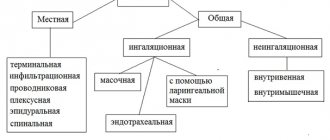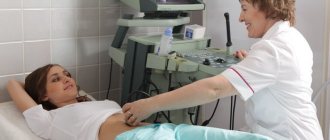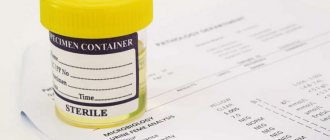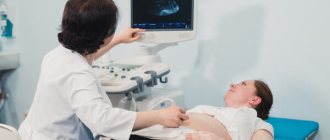Share on social media networks:
The period during which a woman can conceive, give birth and bear a child is called reproductive. Its average duration depends on individual factors. These include heredity, the presence of chronic diseases, bad habits, and adequate nutrition.
The favorable age for conception is considered to be 20-35 years. At this time, most women's bodies are in a state that allows them to give birth to a child. These conditions apply to both natural conception and in vitro fertilization. The older the woman, the higher the risk of having somatic pathology. Most often, by the age of 45, arterial hypertension, diabetes mellitus, and pathology of the abdominal organs and kidneys appear. Many women are observed for gynecological diseases. Diagnosed changes require ongoing or course therapy. Not all medications are compatible with pregnancy and lactation.
However, the age of 45 years is not a contraindication for bearing and giving birth to a child. Before conception, it is necessary to undergo a thorough examination to confirm the body’s readiness for fertilization. Pregnancy can occur naturally or through artificial insemination. According to statistics, the number of successful completions of the IVF protocol at the age of 45 is 7%. This figure is growing every year thanks to modern developments in the field of reproductive medicine.
The influence of age on the success of the procedure
For a married couple who have decided to conceive a child using IVF, the question of choosing a form and biomaterial often arises. Cycles with your own egg, with a donor egg, or with the transfer of a donor embryo are possible.
The selection criterion is usually the state of reproductive health of the mother and father at the time of IVF.
The decisive factors are:
- The quality of the egg and its ability to accept sperm normally;
- The quality of the father's sperm, reflected by the spermogram;
- The presence of genetically transmitted pathologies in one of the parents or other serious diseases affecting the conception and development of the fetus.
Ovarian reserve of full-fledged eggs at different ages
| Age | Ovarian reserve | Level fertility |
| up to 30 years old | 12% | 70% |
| up to 35 years old | 7% | 24% |
| up to 40 years old | 5% | 15% |
| up to 45 years old | 3% | 6,6% |
| up to 50 years | less than 1% | 1,3% |
The younger a woman’s body, the greater the supply of eggs and strength to bear a child she has.
At this age, the risk of miscarriage and the risk of the child developing Down syndrome increases by up to 50%.
Sign up for a test:
Ovulation stimulation
Protocols for ovarian stimulation with hormonal drugs slightly solve the problem with the quality of oocytes. But they are allowed without the use of assisted reproductive technologies only in women with normal ovarian reserve under the age of 35. For women older than this age who have problems conceiving, ovarian stimulation is used as part of the IVF procedure.
Ovarian stimulation allows us to obtain the maximum number of mature oocytes. In order to select the correct stimulation protocol, we look at the level of Anti-Mullerian hormone. To stimulate ovulation, doses are selected based on AMH numbers and when it decreases to less than 0.7 ng/ml, fairly large doses of gonadotropins are used, i.e. women aged 35 years and older and women with low ovarian reserve undergo more aggressive ovarian stimulation.
Moreover, if the patient’s Anti-Mullerian hormone is extremely reduced, then ovarian stimulation is not indicated in this case.
Gynecological diseases in late reproductive age
With age, the incidence of gynecological diseases increases. Up to 40% of women aged 40 years may have uterine fibroids; endometriosis is often detected in patients aged 35-40 years. Due to impaired ovulation, endometrial hyperplasia may occur, the risk of which increases with the age of patients. All this significantly reduces the effectiveness of IVF.
The problem of thin endometrium (insufficient thickness of the endometrium for embryo implantation and pregnancy) is also relevant. Its formation is influenced by disturbances in the blood supply to the uterus, surgical interventions (abortion, diagnostic curettage of the uterus), a history of infectious diseases, etc. And in the vast majority of cases, due to the low effectiveness of IVF for this disease, especially in late reproductive age, the problem of thin endometrium is solved by a surrogate program motherhood.
Obstetric complications in pregnant women over 40 years of age
Obstetric complications often arise due to the fact that any somatic diseases are already accumulating or manifesting themselves. A big problem is gestational diabetes mellitus, arterial hypertension, placenta previa, preeclampsia, the birth of low birth weight babies, the frequency of spontaneous miscarriages is increasing (at 35-39 years old - 21.4%, at the age of 40 years and older - 42.2%), the frequency of surgical delivery and premature birth.
Oocyte donation
An effective method of treating “aging” of the ovaries is the method of oocyte donation, which significantly increases the chances of pregnancy compared to programs of controlled ovarian hyperstimulation and IVF.
For patients aged 45 years and older, we can only talk about the oocyte donation program. Also, at this age, a surrogate mother is often used for pregnancy, since the risk of obstetric complications is very high. The incidence of maternal and infant mortality is higher among postmenopausal pregnant women.
Genetic screening
Women in the older age group should be informed of the high risk of chromosomal abnormalities. In patients 39 years of age and older, preimplantation genetic screening should be mandatory. This helps prevent the transfer of a diseased embryo. Modern medicine cannot currently treat embryos, but doctors can save the patient from unnecessary transfer.
Other methods are invasive: chorionic villus biopsy, amniocentesis. They are now just as widely used, but they force the patient to make a choice: either give birth to a sick child or decide to have an abortion. Therefore, it is preferable to turn to a preliminary genetic study of the embryo.
To summarize, it should be noted that, despite the associated risks, successful pregnancy at a late reproductive age is possible. Assisted reproductive technologies continue to develop and help many couples facing a diagnosis of infertility. But all the problems mentioned above still remain relevant. Therefore, women who want to avoid unnecessary complications during pregnancy and childbirth should seriously think about realizing their reproductive function on time, i.e. up to 40 years old.
IVF with your own egg after 40
Carrying out IVF with your own egg is always the most preferable option in terms of ethics and genetic compatibility. Unfortunately, the natural resources of the female body do not always allow one to resort to this protocol.
The reproductologist’s clear decision will be for the patient to undergo studies of her ovulatory reserve, analyze the quality of her partner’s sperm, and have a blood test for her hormonal profile.
Quite often, IVF at this age is carried out with the ICSI protocol, that is, the fastest and most viable sperm is injected into the cytoplasm of the egg.
ICSI is conditioned by the presence of any of the following circumstances:
- Low sperm concentration;
- A large number of pathologically altered spermatozoa;
- Reduced average sperm velocity;
- Presence of antisperm bodies;
- Pathologies of reproductive cells that cannot be accurately diagnosed.
In vitro fertilization with one's own eggs, performed on a woman over 40 years of age, is possible in the following cases:
- Menopause has not yet passed, and the applicant has her full-fledged oocytes;
- The endometrium of the uterus is capable of receiving the embryo and ensuring its full maturation;
- The oocytes of the expectant mother are devoid of structural changes in chromosomes that occur with age and are genetically healthy.
If an embryo with a genetically modified code is transferred into the uterus, there is a danger of fetal death due to the mother’s body not accepting the genetically alien embryo.
Factors affecting the ability to get pregnant
Unfortunately, in addition to a decrease in the number of ovulatory cycles, health problems may appear with age that affect, if not conception, then the course of pregnancy. This is why doctors recommend not delaying the birth of a child. But if this does happen, you first need to find out whether the woman can get pregnant and carry a baby.
The possibility of a natural pregnancy depends on many factors:
- the presence or absence of somatic, endocrine and infectious pathology;
- individual characteristics of a woman’s body;
- the speed of development of involutive processes leading to the extinction of the functional activity of the reproductive system.
If a woman wishes to become pregnant, the specialists of our clinic will prescribe an objective study, the purpose of which is to determine the criteria that influence the possibility of fertilization and the subsequent normal course of pregnancy and childbirth.
Diagnostic studies carried out at the AltraVita clinic include:
- Hormone tests. A laboratory determination of the level of sex hormones is performed on different days of the cycle, and the ovarian reserve is determined.
- Instrumental research. Hysteroscopy, colposcopy, hysterosalpingography, ultrasound of the pelvic organs and other studies allow us to assess the condition of the reproductive organs. With age, the likelihood of developing gynecological diseases increases. Many of them negatively affect fertility.
- Assessment of physical health status. A woman needs to have a coagulogram, blood tests for sugar and thyroid hormones, an ECG, fluorography, ultrasound of the mammary glands and some other studies.
They allow you to determine whether there are any contraindications to pregnancy. Then preparations for the in vitro fertilization protocol begin.
An assessment of the general condition of the body is necessary, since during pregnancy the load on many organs increases: heart, kidneys, etc. Hormonal levels change, immunity decreases. All this can lead to the development of various complications in the mother and fetus, then a pregnancy that has been so difficult may have to be terminated for medical reasons, which will become not only physical, but also emotional trauma for the patient.
When preparing for IVF after 40, the AltraVita clinic may prescribe the following studies:
- tests of smears from the urethra and vagina for sexually transmitted infections;
- blood tests for particularly dangerous infections;
- cervical smear cytology;
- clinical blood and urine tests;
- blood chemistry;
- examination of doctors of various specialties.
If necessary, the diagnostic process and determination of a woman’s ability to become pregnant includes a study of a man to diagnose the possible presence of infertility in him. At a minimum, the spouse must take a spermogram. Based on its results, the issue of carrying out additional diagnostic measures is decided.
The condition of the ejaculate also matters for program selection. Thus, if sperm motility is impaired or pathological forms appear in sperm, it may be necessary to carry out morphological selection of sperm and intracytoplasmic injection (ICSI).
If criteria are identified that sharply reduce the possibility of conceiving a child and the normal course of pregnancy in a woman, the center’s doctors can recommend an IVF program after 40 years.
Natural conception is a matter of chance, which often depends on many factors. Even if you accurately determine the day of ovulation and create all the necessary conditions for fertilization, conception may not occur.
During an IVF protocol, ovulation stimulation allows multiple eggs to be collected. And if some of them are not fertilized, there remains the possibility of obtaining a full-fledged embryo for transfer to the uterus.
Another problem for those who decide to get pregnant after 40 years old is the risk of having a sick baby. The likelihood of a newborn developing Down syndrome and other pathologies at this age increases sharply. With in vitro fertilization, it is possible to select high-quality embryos using PGD. This not only reduces such risks, but the woman does not waste precious time, because with age new problems and diseases may appear. And unnecessary psychological trauma due to failure can also affect a woman’s condition.
According to research by scientists at the University of Adelaide, who analyzed more than 300 thousand natural births and 3,600 in vitro fertilization procedures in older patients, interesting data were obtained. It turns out that birth defects in “test tube babies” appear much less frequently in 3.6% of cases than in those conceived naturally at this age. This figure is even lower than for women giving birth over 29 years of age. That is, after forty, IVF is not only effective, but also reduces the risk of developing abnormalities in the fetus.
It has been suggested that the drugs used in the protocol may have a positive effect. Although careful selection of implanted embryos plays an important role.
Indeed, in life, many pregnancies are terminated at such a short time that women do not even notice it. The fetal tissue is excreted with menstrual bleeding. This is how nature gets rid of embryos with serious pathologies. And with artificial insemination, the best quality germ cells and an embryo are selected for transfer.
IVF with donor oocytes after the age of forty
The IVF protocol with donor oocytes has a number of features:
- The reproductive specialist selects oocytes of the highest possible quality;
- Even in the presence of a donor egg, the woman who will bear the child is the one who will raise him, so the emotional contact with the unborn child is high;
- The cycles of the female donor and recipient are synchronized.
The IVF clinic on Petrovka has achieved more than 65% success in the IVF protocol with donor oocytes.
When deciding whether to apply a donation program to a patient, you should pay maximum attention to complete information about the donor. The IVF clinic on Petrovka has its own storage bank of cryocytes and frozen embryos, the condition of which is determined by the most experienced embryologists. You can find out about the cost of donor material on the clinic’s website.
Chances of IVF with your own egg and donor egg
Not only does the number of eggs decrease with age; their quality also suffers. As you remember, these structures are laid before a woman is born, so all the negative influences - toxic products, nicotine, previous diseases, poor blood supply - accumulate.
As a result, eggs lose their ability to fertilize, and the risk of chromosomal abnormalities increases, so the embryo may stop developing at a certain stage. That is why IVF after 40 with one’s own egg is not used for all couples; in 5% of cases an oocyte donor is needed.
Donor eggs are sometimes the only way a woman can get pregnant and carry a child to term. For this purpose, an oocyte is collected from a young and healthy woman, whose menstrual cycle will be synchronized with the cycle of the recipient woman using pharmacological drugs.
IVF with donor embryos after 40 years
After reaching the 40th birthday, the risk of a lack of healthy eggs in the patient or low quality sperm in the intended father is high. The danger of chromosomal mutations also increases. In such a situation, the IVF clinic on Petrovka offers the transfer of donor embryos.
The effectiveness of such a protocol is up to 20%. There are two main stages in this case: preparation of the patient’s endometrium and direct embryo transfer.
The main problem in this type of IVF is bioethics: the lack of genetic affinity between parents and child.
IVF during menopause
In order to make a decision about using the possibilities of IVF during menopause, you should be aware of the following nuances:
- IVF is possible only if there is a healthy endotherm of the uterus;
- An embryo can be obtained as a result of fertilization with the husband's seed;
- The patient must undergo hormone replacement therapy;
- It is possible to use your own, previously vitrified, oocytes.
Ovarian hyperstimulation syndrome, which occurs during hormone replacement therapy, often goes away within two weeks and causes severe consequences only in 1.5% of cases. The IVF protocols carried out by specialists at the IVF clinic on Petrovka are not burdened by the development of this side effect.
Age limit for IVF
In vitro fertilization is a method of assisted reproductive technology, with the help of which conception is carried out outside the female body, after which the formed embryo is transferred into the uterine cavity.
It is assumed that there are certain age limits for the IVF procedure. However, much depends on additional indicators of the female body: ovarian reserve, hormonal balance, endometrial condition and others. Age also plays an important role. It is possible to perform in vitro fertilization until the woman’s reproductive function has died out.
For most representatives of the fairer sex, the likelihood of natural conception decreases after 35 years; getting pregnant after 40 becomes more difficult. By the age of 45, the reproductive system functions differently than at the age of 20. After 50, half of women experience menopause. It is not possible to conceive and bear a child at this age. However, the efforts and developments of scientists have done the impossible, as a result of which the birth of a child conceived in a test tube has become possible even by the age of 50.
Numerous observations have established the age up to which successful IVF can be done.
Women aged 22-30 years have an 80% chance of successfully conceiving. Patients in the age range of 30-35 years – only 60%. The desire to conceive a child using ART in women under 40 years of age is fulfilled only in 35% of cases. After 40, the probability of a successful outcome continues to decrease and is no more than 28%.
Due to the influence of certain factors (heredity, stimulation, hormonal treatment, surgery), menopause may occur earlier. Some patients already experience all the signs of menopausal syndrome at the age of 30. In this case, conception is not possible even for a young woman. The average age at which IVF is performed is 45 years.
IVF in a natural cycle after 40
IVF in the natural cycle after 40 years is practically not widely used for the following reasons:
- Due to physiology, a woman over 40 has an extremely low chance of getting an absolutely healthy egg;
- If you are lucky enough to obtain a relatively complete egg, the chances that this particular embryo will be viable are low;
- Spontaneous ovulations often interfere with the prescribed protocol;
- It is possible to mistakenly pick up an immature egg by puncture;
- The follicle may be devoid of an egg.
The chances of conceiving with your own egg after 40 years are 10%. This relatively low percentage can be increased by following all the recommendations of the specialists at our IVF clinic in Petrovka regarding lifestyle changes and medication support in preparation for conceiving and bearing a child.
Factors that reduce the success of IVF after 45 years.
The main question for every mature woman who has decided to experience the joys of motherhood is: “does IVF bring positive results after 45 years?” Unfortunately, there are many factors that reduce the chances of positive results after IVF.
- The most important factor reducing the chance of successful conception and pregnancy, unfortunately, is age. For women over 43 years of age, the chances of successful IVF are less than 10%.
- Using your own egg and seminal fluid for the procedure. When using donor eggs and sperm, the chances of success increase by 2 times.
- What kind of procedure is this? The highest chances of getting pregnant during the first procedure. With each subsequent one they sharply decrease.
- Deficiency or excess body weight. This is due to the fact that a woman with normal body weight has better egg implantation and a lower risk of miscarriage.
- Duration of infertility. Regardless of whose side the infertility problem was (men or women), the longer it exists, the more difficult it is to get pregnant in the future.
- The presence of diseases of the reproductive system, of any origin.
- The presence of chronic diseases that affect blood vessels and nerves - arterial hypertension, diabetes, Raynaud's disease, and so on.
- Smoking and frequent drinking of alcohol by a woman also negatively affects the success of this procedure.
- Leading a sedentary lifestyle greatly impairs blood flow in the pelvic organs and thus has a bad effect on the future procedure.
- Malnutrition causes a deficiency of vitamins, microelements and essential amino acids, without which normal fetal development is impossible.
Long and super-long protocols after 40
When using a long and super-long protocol, the production of the patient’s own hormones is blocked through the administration of hormonal drugs.
Features of the protocol:
- The beginning of the use of hormonal effects is 21 days of the previous cycle;
- Daily injections of gonadotropin-releasing hormone agonist drugs are used;
- On days 1-3 of the menstrual cycle, FSH and LH are prescribed;
- The puncture is performed two weeks from the beginning of the cycle.
The super-long protocol involves the use of drugs that cause artificial menopause, which leads to regression of pathologies in the tissues of the uterine cavity. After the functions of this organ are restored, superovulation is stimulated.
Long and super-long protocols after 40 years are used for fibroids or endometriosis, or if it is necessary to correct the patient’s immune system.
How effective is IVF at older ages?
In normal health, intercourse during ovulation leads to pregnancy in 30% of cases. Many fertilized eggs die early and are released along with menstrual blood. Modern reproductive technologies have made it possible to increase the number of pregnancies to 40% with good maternal health and high-quality reproductive cells. The death of embryos occurs due to genetic abnormalities that cannot be influenced or predicted.
But women with various gynecological diseases that do not allow them to conceive a child on their own come to the IVF procedure. Therefore, the likelihood of a successful pregnancy and birth of a child is even lower.
IVF statistics after 40 years indicate pregnancy in less than 20%, but the number of births is much less. At this age, the risk of miscarriage is higher, so not everyone is able to carry a child to 40 weeks. The older the expectant mother, the lower the chances of pregnancy occurring on the first try. Therefore, many resort to cryopreservation of eggs or embryos to repeat the attempts.
Short protocol
For patients over the age of forty, the short protocol is rarely used. What distinguishes the short protocol from the long protocol is the time of initiation of the use of the GnRH agonist, which is administered starting from the 1st day of the cycle, and FSH is started to be administered the very next day.
After reaching the age of forty, the ovarian response to stimulation is not always predictable and there is a risk of developing OHSS. Therefore, at this age, the choice of longer, more gentle regimens is justified.
Natural cycle and other protocols
IVF does not always involve interfering with the mother's hormonal system. Even after 40 years, in vitro fertilization in a natural cycle is allowed if the first attempts to get pregnant after ovulation stimulation resulted in the formation of 1-2 eggs. In this case, hormonal stimulation of the ovaries is not justified. The use of hormonal drugs in women who have had cancer of the reproductive organs or are prone to thrombosis is dangerous.
In the natural cycle, the maturation of the egg is monitored using daily ultrasound, and the puncture is done until the natural rupture of the follicle. The oocyte is fertilized and grown for up to 3-5 days. After this, it is placed into the uterine cavity.
In mature women, after implantation of good quality embryos obtained as a result of stimulation, implantation is not always successful. Therefore, the remaining embryos are frozen and the next attempt is made in the natural cycle.
For women with endometriosis after 40 years of age, IVF will be effective if the number of immature eggs in the ovaries is large and the lesions have been previously cauterized.
But the percentage of pregnancy in a natural cycle with your own egg at this age is very low. Therefore, they resort to various methods of stimulation.
Long and super-long protocols
The long IVF protocol is most suitable for women over 40 years of age. This technique uses drugs that block the production of luteinizing hormone. Therefore, ovulation does not occur and many follicles mature, from which oocytes can be obtained.
In a long protocol, each stage is controlled, so there is less chance of spontaneous ovulation, during which it is impossible to obtain germ cells. The pregnancy rate using this protocol is significantly higher. It is recommended for the following conditions:
- violation of the patency of the fallopian tubes;
- age-related changes in the ovaries;
- a small number of oocytes according to the examination results;
- excess male sex hormones;
- endometrial hyperplasia, fibroids, endometriosis;
- unsuccessful attempts to become pregnant in other protocols.
The use of the technique is pointless in cases of frequent abortions in the past or chronic inflammatory diseases of the uterus. They lead to changes in the structure of the endometrium, so successful implantation becomes impossible.
Despite many advantages, a long protocol may fail and lead to ovarian hyperstimulation syndrome. To obtain oocytes, stimulation is carried out over 2 weeks. But the body reacts to the same doses of hormonal drugs differently. In some cases, the ovaries may become greatly enlarged, swelling may develop, fluid may accumulate in the abdominal cavity, and sometimes thrombosis may occur. In this condition, embryo transfer is not possible.
Successful IVF after 40 years is possible with a super-long protocol. This is a technique that is used in women with fibroids and endometriosis. First, they are prescribed drugs that cause artificial menopause. This leads to regression of pathological foci in the uterus. After this, reproductive function is restored and superovulation is caused.
Short protocol
If the long protocol led to failure, a short version is used for older patients. Its duration coincides with the natural menstrual cycle, the production of its own hormones is not completely blocked.
A short protocol is carried out when there is a high risk of developing ovarian hyperstimulation. The method has disadvantages. Due to the refusal to use certain drugs, the synchronicity of maturation of the endometrium and oocyte may be disrupted. The follicles will contain eggs ready for fertilization, but the uterine mucosa will be thin for embryo transfer. Therefore, implantation may not occur.
Cryopreservation and vitrification
During the long protocol, a large number of eggs are obtained. But they are not used in the same cycle. After fertilizing several and obtaining high-quality embryos, the remaining eggs or embryos are offered to be vitrified or cryopreserved.
Cryopreservation is an old method that involves gradually cooling cells slowly and freezing them in liquid nitrogen. The disadvantage of this technique is the risk of damage to the material by ice crystals during defrosting or storage. This method is more expensive. Older women should not use it. If the resulting embryos die, it may make it impossible to continue trying to get pregnant.
Vitrification is a modern technique for preserving oocytes or embryos. To prevent cells from being damaged by ice crystals, before freezing, water is removed from them using special preparations and replaced with a gel-like substance. Such embryos can be stored for many years without the risk of their death or the impossibility of recovery after thawing.
The use of vitrification is suggested for patients who are undergoing treatment for cancer, in which it is possible to preserve the reproductive organs. During a course of chemotherapy or radiation therapy, germ cells are damaged, and if they are frozen, you can become pregnant using IVF even after the 40-year mark.
Donor egg
Older women are often offered the use of donor cells. Your own egg cannot always produce a high-quality embryo. If the patient has had unsuccessful attempts to become pregnant, it is natural to find a donor. Most often, close relatives or acquaintances act in his role. The use of a donor egg for IVF is indicated in the following cases:
- no ovarian response to stimulation;
- imminent onset of menopause;
- violation of the development of the gonads;
- the woman has undergone chemotherapy or radiation therapy;
- own ovaries removed;
- Genetic diseases that can be inherited have been diagnosed.
Cryopreservation and vitrification
Cryopreservation, or freezing, of oocytes or embryos allows us to solve the following issues:
- Carrying out IVF with your own eggs years after cryopreservation, including after a woman reaches 40 years of age;
- Increased chances of results, as a larger number of oocytes are selected;
- Allows replantation in cases of low chances associated with the presence of diseases of the uterine cavity and dysfunctions of this organ;
- Transfer cryoembryos for cervical canal stenosis;
- To undergo IVF for various reasons, social or medical and reproductive.
Vitrification is a process of ultra-fast, very embryo-friendly, freezing of cells or embryos at ultra-low temperatures, in which the embryo tissue is not damaged by ice crystals. This assisted reproductive technology, along with dozens of advanced ART technologies, is successfully used in our IVF clinic on Petrovka, allowing us to increase the effectiveness of the protocol to 70%
Minimum age for IVF
Infertility and age are closely related to each other due to the possibility of conception. Fertility develops in women after puberty and ends with the onset of menopause. Therefore, it was established by law that the minimum age for IVF is 18 years.
It is important to understand that for young girls such a step is not a priority for the treatment of infertility, unless we are talking about severe pathologies of the reproductive system, so doctors will offer conservative therapy with the goal of achieving pregnancy naturally.
The biological age of the patient is one of the most important discussions among modern reproductive specialists. Each case of infertility requires an individual approach. Based on examination data, drug indicators, FS, the question of the method of conception is decided. An important role is played by the opportunity to obtain a healthy egg for IVF, if we are talking about such a procedure.
Stimulation of superovulation
Ovarian stimulation is also quite acceptable for women who have reached 40 years of age, provided they have not yet reached menopause. It is in this case that an adequate response of the pituitary gland and ovaries to the therapy used is possible.
External effects are carried out by reproductologists in case of absence of ovulation for at least six cycles, or if a couple wishes to conceive twins.
Unfortunately, any change in hormonal levels is fraught with negative consequences for a woman’s health. One of the unwanted side effects in this case is ovarian hyperstimulation syndrome. Ovarian stimulation is not performed during menopause and endometriosis.
As a rule, in 15% of patients of reproductive age, pregnancy occurs after the first stimulation prescribed according to the indications of reproductive specialists.
Stimulation in IVF is a pharmacological effect on the body that leads to follicle maturation and ovulation. Side effects may include ectopic or multiple pregnancies, or the development of allergies to medications.
PGD of the embryo before transfer
To exclude chromosomal abnormalities, the chance of which increases with age, preimplantation diagnosis (PGD) is used in IVF programs after 40 years of age. This is additional testing of an oocyte fertilized in a test tube, which has already begun the process of division, before it is introduced into the woman's uterus. The same term is used to study an egg even before fertilization, if this woman suffers from a genetic pathology
One cell is taken for analysis at the stage when there are from 4 to 10 such blastomere cells (this is the 5th day of embryo development) and they are still absolutely identical. It is studied under a microscope, and some laboratory tests are performed (fluorescent hybridization, polymerase chain reaction). If no anomalies are found, the embryos are transferred into the uterus on the same or the next day. The time frame for the study is extremely short, since subsequently the embryo will not be able to continue development outside the mother’s body.
Preimplantation diagnosis creates a high probability of having a child without genetic pathologies. It approximately halves the risk of miscarriage and multiple pregnancy, and also adds 10% to the chance of successful embryo implantation.
PGD is possible only within the framework of ICSI and ICSI IMSI. It is carried out in the laboratory, without additional effort on the part of the woman or her husband. It is possible both for couples who planned IVF after 40 with their own egg, and for those who used a donor oocyte.
Recommended protocols for IVF after forty years
The age of the woman who decides to resort to IVF determines the range of available protocols. The most effective in this case are two of the variety of protocols:
- Stimulated IVF cycle;
- Carrying out IVF in a natural cycle.
In a stimulated cycle, two main protocols are used: short and long. During SC, a woman experiences the effects of gonadotropin drugs. Today, such medications as Metrodin, Menogon, and Pergonal are popular.
When carrying out a natural cycle, hormonal drugs are practically not used, but there are risks associated with the small number of eggs that can be used for fertilization. In technical terms, the difficulty is in monitoring the follicles and choosing the exact time for puncture collection.
In our clinic, an experienced reproductive specialist determines the general strategy and tactical decisions of IVF, taking into account the couple’s medical history, the success of previous protocols, the characteristics of the reaction to hormonal drugs, and the presence of cryopreserved oocytes or embryos.
Risks during pregnancy
Even as a result of a successful IVF protocol, there remains a significant number of risks associated with bearing a fetus. Spontaneous termination in the first trimester ends in 25 to 30% of pregnancies.
The causes of miscarriage during this period are:
- Immunogenetic;
- Infectious processes that cause inflammation;
- Serious hormonal changes in the body.
Immunogenetic changes include tissue incompatibility between men and women according to the gradation of human leukocyte antigens HLA, changes in the chromosomes of the germ cells of spouses, and the presence of specific antibodies to gonadotropin.
Infectious causes are characterized by the consequences of the presence in the mother’s body of untreated MPS diseases: cytomegalovirus, mycoplasmosis and the like.
Endocrine disorders are represented by insufficient function of the corpus luteum, hyperandrogenism, and decreased estrogen levels.
In the second and third trimester, miscarriage can be caused by the following reasons:
- Intrauterine infections leading to antenatal death of the pregnant child;
- Isthmic-cervical insufficiency caused by multiple births;
- Placental insufficiency, leading to disruption of metabolic processes between mother and fetus and to disturbances in fetal development.
All these risks are subject to correction by reproductologists and, with the use of competent drug treatment, can be quite successfully overcome. Women who are under inpatient observation at the IVF clinic on Petrovka, or who are observed with us on an outpatient basis, are three times less likely to end their pregnancy prematurely compared to those who are observed in regular consultations.
Positive IVF results after 40
Considering the objective risks of IVF after 40 years, it is worth taking a number of measures aimed at increasing the chances of a successful pregnancy, resulting in the appearance of an IVF child. This outcome is facilitated by the normal state of the genitourinary system, including the quality of parental reproductive cells, and the mother’s ability to bear a fetus.
The following steps are recommended:
- A thorough examination in a high-quality clinic specializing in IVF;
- Determination of ovarian resource and spermogram analysis;
- Carrying out therapeutic measures and correction of hormonal levels;
- Conducting embryo hatching and preimplantation diagnostics;
- Elimination of physiological and social factors that can interfere with bearing a child;
- Carrying out general health measures, including vitaminization;
- Pregnancy support after IVF procedure.
How much each of these stages costs and how you can sign up for a consultation can be found in the relevant sections of our clinic’s website.
Statistics show that the success of IVF after 40 years of age decreases every year: at the age of 40 to 41 years, a positive result occurs in 15%, before 43 years of age you can expect 6% of success, but after 44 years of age there is only 1 chance in hundreds of procedures performed.
How is IVF carried out?
Eco is a very complex procedure, it is carried out in a strictly defined order. Its duration is individual for each woman. A fertility specialist monitors each stage of IVF.
When IVF is performed after 40 years, positive results are only possible if the protocol is well-written and the woman follows the doctors’ instructions flawlessly.
- The very first, very important stage is a medical examination of future parents. By this period, they must give up bad habits, stop smoking and drinking any alcohol with beer, inclusive, 6-7 months before the IVF protocol - alcohol and nicotine contribute to the development of pathologies in the fetus, even before its intrauterine death.
- Stimulation of superovulation to obtain the required number of mature eggs.
- Puncture, or collection of the obtained eggs.
- Fertilization itself, which is carried out in a completely sterile laboratory. A man should also prepare for this stage. Sometimes surgery may be required to collect semen. Regardless of the method of obtaining, it is examined in the laboratory and the most morphologically suitable and healthy sperm are selected for fertilization. The obtained eggs are examined in the same way. In vitro fertilization is carried out 4-6 hours after receiving the eggs; this process lasts several hours.
- Cultivation of embryos is done by embryologists. During this period, cells begin to rapidly divide and an embryo is formed.
- On days 5-7, the embryo is implanted into the uterine cavity.
This, in fact, ends the IVF procedure; now other doctors will monitor the woman’s condition. Now, with the development of medicine, successful IVF after 40 years is becoming more and more common, and complications after them remain less and less.
You will certainly have “extra” embryos that were not transferred to you. They will be cryo-frozen so that they can be used after some time, if the implanted embryos do not take root this time, or you want to carry another pregnancy. In this case, you will no longer have to go through all the stages of IVF; your ready-made embryo will be waiting for you at the clinic.
Consequences for a woman with IVF after 40 years
Pregnancy is a physiologically quite stressful process for a woman, and the IVF procedure applied at the age of “over 40” carries an additional burden on the body.
The consequences are:
- Hormonal disorders caused by the use of ovarian stimulation and non-hormonal medications used;
- Risks of unplanned multiple pregnancy;
- Miscarriage at different stages;
- Risks of genetic abnormalities caused by errors in the chromosomes of germ cells accumulated with age;
- The formation of placental insufficiency and the associated risks of abnormalities in fetal development;
- Placental abruption caused by increased stress during IVF and previous illnesses;
- Difficult pregnancy associated with the general condition of the body, which by this age has a number of chronic diseases.
The perceived risks and undesirable consequences of IVF after the age of 40, caused by a decrease in the ability to bear a child and somatic pathologies, can be reduced by resorting to the help of highly qualified reproductive specialists at the IVF clinic on Petrovka.
What are the indications for IVF?
IVF at 40 years of age can also be performed according to indications. The introduction of an embryo into the uterus is a complex intervention for a doctor, so the procedure has clear indications for implementation. The most common problems of patients undergoing in vitro fertilization are pathologies and conditions that lead to a decrease in the fertility of the woman or her partner. These include the following.
- Tubal-peritoneal factor, when the function of the fallopian tubes is impaired, their patency, or they are absent as such. There are two possible treatment options here - surgery and IVF, which is considered a minimally invasive technique and gives better results.
- Male factor is a pathology of sperm or male reproductive cells.
- Endometriosis. There are also two treatment options available here - surgical and IVF, with the second being preferred due to its low invasiveness. It is important to understand that this procedure is much more expensive.
- Age.
- Lack of ovulation. Stimulation techniques are used here, which also occur during IVF. Quite often, against the background of ovulation stimulation, intrauterine insemination of sperm is performed, but if such a procedure does not achieve the desired effect, then the use of the IVF procedure is considered the best option to solve the problem.
- Unexplained infertility. This type of pathology reaches 15% of childlessness. IVF is considered the most effective method of treating the problem.
In vitro fertilization after 40 years is a subject of debate for modern reproductive specialists. But it can be called the last chance for a woman to give birth to a child, so the procedure must be approached with maximum responsibility to obtain positive results.
Where is IVF done after 40 years in Moscow?
When choosing a clinic in Moscow for an expectant mother who has already crossed the threshold of her fortieth birthday, you need to be guided not only by where treatment will be inexpensive. It is worth analyzing the statistics and comparing the indicators of positive results of this particular direction of IVF in different clinics of the same class. An important point is the presence in the infertility treatment center of the most modern diagnostic and reproductive equipment, highly qualified personnel, the presence of its own donors and the quality of postoperative support.
You should also pay attention to reviews that reflect the nuances of the relationship and professional approach to the patient’s problems. Prices at the clinic are relatively cheap with high quality standards.
The IVF clinic on Petrovka has an excellent opportunity to conduct IVF protocols for women who have reached the age of forty. The clinic’s professionals, who have experience working in similar centers in Europe, Israel and the USA, have achieved the absence of such severe consequences as ovarian hyperstimulation syndrome and various complications after puncture, and the effectiveness of IVF in the clinic reaches 90% within a year from the date of treatment.










